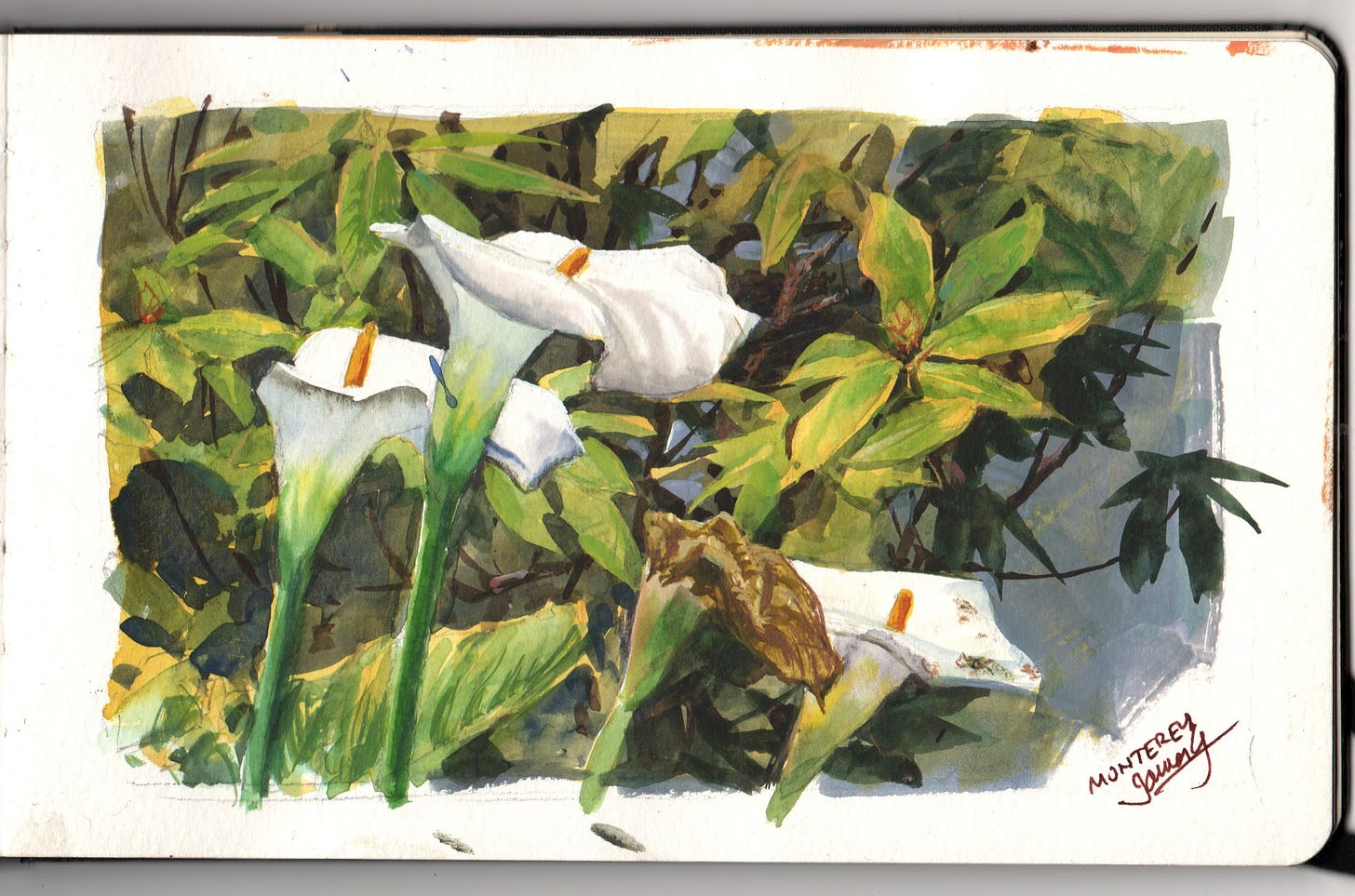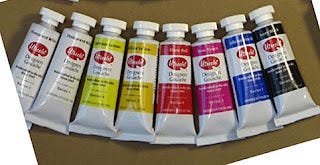James Gurney, Calla lilies, watercolor and gouache
Joseph Gyurcsak, an artist and brand manager for Utrecht art supplies, wrote to me offering to answer any questions I might have about gouache. He told me that he worked on developing Utrecht's line of gouache for more than two and a half years, and that he learned a lot about the medium during that time.
[Gurney] How would you define gouache compared to other water-based media?
[Gyurcsak/Utrecht] "Firstly, I would like to say by definition gouache is OPAQUE watercolor for those who are confused. Gouache colors were not intended to have the same vibrancy as watercolor because the formulation properties are entirely different. They can be permanent and long lasting; just look at the works of John Singer Sargent or Winslow Homer's wonderful interplay of transparent washes (watercolor) with semi-transparent and opaque passages of gouache. There are times when this interplay (transparent, opaque and impasto) is done as masterfully as an oil painting!
"One more truth: opaque colors in any medium and any brand color line will never carry the vibrancy of color intensity compared to any semi-transparent or transparent color when mixed with white! I preach this color mixing law to all students in my demos and lectures."
[Gurney] When you helped develop the Utrecht line, what qualities did you want to achieve in the paint, and how did you do it?
[Gyurcsak/Utrecht] "Gouache colors are very delicate formulations. They need to be opaque, even with pigments that don't want to go this way because of their nature. [They should have a] Flat to satin sheen, [and should] lay down flat, continuous washes without striking [Ed. streaking?] when dry, if possible (mainly for designers), flash dry (for rapid layer build up) and have the ability to create thin detail lines if needed. This is complex and demanding, and that is why the formulations are so very delicate in the pigment-loading ratios compared to all other ingredients.
[Gurney] What's different about Utrecht gouache?
[Gyurcsak/Utrecht] "Utrecht gouache is different in way of price. We try to be affordable for all level artists to enjoy professional level materials."
[Gurney] Is there any way to retard the drying time in gouache, especially when using it in arid conditions?
[Gyurcsak/Utrecht] "This is opposite to its flash dry [Ed. quick-drying] properties but if an artist must, ox gall or glycerin (with eye dropper) used sparingly will buy some more time."
[Gurney] Is there any way to eliminate the value changes as gouache dries?
[Gyurcsak/Utrecht] "The shift is going to happen especially more when colors are opaque in gouache and acrylic. Artists develop a sense for working with various mediums and know how to mix in anticipation. Most good instructors advise a test scrap, or as we have seen in artworks from the past at museums, this testing done on borders outside the picture boundaries. I especially love seeing this, as it shows the artist thinking in color notes! Frederick Remington comes to mind."
[Gurney] Are there any grounds or surfaces that should be avoided when using gouache?
[Gyurcsak/Utrecht] "Slick ones, gouache wants to peel from these more plastic type surfaces."
[Gurney] Can gouache be used as a substrate for other painting media, such as oil?
[Gyurcsak/Utrecht] "Yes, watercolor, chalk pastel, acrylic and oil color. It must be sealed with a Krylon clear spray for oil, to avoid oil bleeding and staining the colors."
[Gurney] Do you recommend varnishing gouache to get more depth of color and glossiness? What sealers or varnishes would you recommend using or avoiding?
[Gyurcsak/Utrecht] "Krystal clear Krylon is excellent for this, but beware, it is permanent, so rework may be difficult after application. But it will bring increased depth, and many illustrators and designers use this. Believe it or not, a simple non-museum glass in framing gives it depth."
Painting Calla Lilies in Monterey, Calif.
[Gurney] Here are some additional answers to your questions
NatalieBarahona: Do you always do an underpainting for gouache plein air studies?
[Gurney] No, I generally paint directly on the watercolor paper. I use an underpainting either to provide some interesting color possibilities or to seal up the fibers of the paper. Burt Silverman often worked in gouache over gesso, or he primed watercolor paper with a thin layer of white gouache underneath watercolor. (continued after the break)
Keep reading with a 7-day free trial
Subscribe to Paint Here to keep reading this post and get 7 days of free access to the full post archives.








